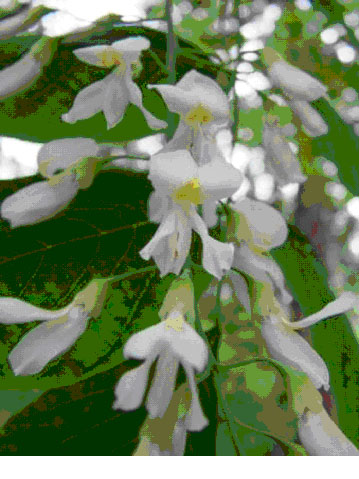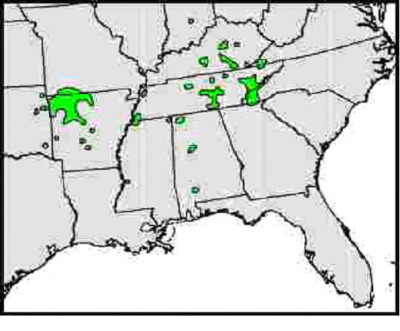Rare Beauty – The Yellowwood Tree
By Lenny Farlee and Keith Woeste
The yellowwood tree, Cladrastis kentukea, is one of the rarest –and most spectacular-hardwood trees in the eastern United States. Although found as a native tree in 12 states and planted as an ornamental tree in several more, it is uncommon to rare across most of its range. In Indiana, Yellowwoods are found as native trees only in Brown County, where they have a state forest named after them. The yellowwood trees in Brown County State Park and Yellowwood State Forest represent the most northerly native populations of the species and the trees there are isolated from the next nearest populations in Kentucky by more than 100 miles. In Brown County, the trees are found almost exclusively in small groves on steep north or northeast facing slopes extending from the central portion of Brown County State Park to the Crooked Creek Lake area of Yellowwood State Forest. The Ogle Hollow Nature Preserve and trail in Brown County State Park is a good location to see native yellowwood, but be prepared to negotiate some steep slopes.
Yellowwood is named for the bright to muted yellow color of the tree’s heartwood. The wood color may gradually turn to a medium brown with exposure to air and light. Because of the rarity of the tree, what little wood that is available originates from salvaged landscaping trees in Indiana. Past and present uses for the heavy, strong wood includes wood turnings, custom furniture, and, historically, gun stocks. Yellowwood branches often emerge at steep, upright angles, making them susceptible to breakage and wind damage.
The yellowwood tree is famed for its beautiful white flower clusters that appear in June and resemble white wisteria blooms. Trees in sun or partial shade can be nearly covered in these waterfalls of blossoms, but the flower show only appears at best every other year. The bark of yellowwood is smooth and gray on young and middle-aged trees, looking very similar to beech bark. Old trees can have rougher bark that may be darker in color. The leaves are compound with the base of the leaf completely covering the bud. Leaves may turn a bright yellow in the fall, adding to the attractiveness of the tree. Yellowwood is a member of the bean family, which includes trees like redbud and honey locust. This tree is moderately slow growing and of medium size compared to many other hardwoods, but can grow and survive on either alkaline or acidic soils. Flower clusters on yellowwood
Flower clusters on yellowwood
Ornamental use of this tree is recommended where a medium sized tree with good flowering and interesting bark are desired. It can tolerate shady spots or full sun, but will bloom best in sunny locations. Trees grown in open conditions will tend to branch very close to the ground, so some pruning to produce good branch structure and eliminate V-shaped main branch unions can increase useful lifespan. Trees growing in a forested area will tend to have longer trunks with less branching, but still have a tendency to have forks and crooks. Deer appear to enjoy browsing on yellowwood, so some protection may be needed if you plant the tree in areas with high deer populations.
Many yellowwood populations, including the native Indiana groves, tend to exist on what are effectively islands of appropriate habitat, isolated from other yellowwoods. The flowers are pollinated by insects, so spread of pollen is limited by the travel distance of the pollinators. Staff of the Indiana chapter of The Nature Conservancy approached the Hardwood Tree Improvement and Regeneration Center (HTIRC) at Purdue University to investigate the genetic composition of the Indiana yellowwoods to see if the population had unique characteristics compared to other populations in the US. The HTIRC is a partnership between the US Forest Service Northern Research Station, the Department of Forestry and Natural Resources at Purdue University, and several other organizations and enterprises; HTIRC’s mission is to explore the genetics and management of fine hardwood trees. Researchers at the HTIRC collected leaf samples from yellowwood populations in Indiana, Missouri, Kentucky, and Arkansas for comparison. Each of the populations demonstrated significantly different genetic characteristics, indicating they have probably been isolated from each other for a long time and are evolving as independent communities.  The Native range of yellowwoodThe Kentucky and Indiana populations had the least evidence of in-breeding and loss of genetic diversity. This suggests these populations have either been separate lineages for a very long time, or are isolated remnants of an earlier single population that have been evolving independently of each other due to the great distances between groves. Even the individual groves sampled in Indiana showed moderate genetic separation from one another, reflecting a lack of cross-pollination between groves that may be less than one mile apart. The future of yellowwood in Indiana is not currently in question, but will ultimately depend on its ability to produce new generations of trees on these islands of suitable habitat.
The Native range of yellowwoodThe Kentucky and Indiana populations had the least evidence of in-breeding and loss of genetic diversity. This suggests these populations have either been separate lineages for a very long time, or are isolated remnants of an earlier single population that have been evolving independently of each other due to the great distances between groves. Even the individual groves sampled in Indiana showed moderate genetic separation from one another, reflecting a lack of cross-pollination between groves that may be less than one mile apart. The future of yellowwood in Indiana is not currently in question, but will ultimately depend on its ability to produce new generations of trees on these islands of suitable habitat.
Lenny Farlee is an Extension Forester with the Hardwood Tree Improvement and Regeneration Center located at Purdue University. Keith Woeste is Molecular Geneticist with the USDA Forest Service, Northern Research Station, Hardwood Tree Improvement and Regeneration Center, and adjunct assistant professor of forestry in the Department of Forestry and Natural Resources at Purdue University.
